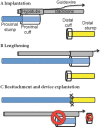Peripheral nerve lengthening as a regenerative strategy
- PMID: 25317163
- PMCID: PMC4192963
- DOI: 10.4103/1673-5374.139471
Peripheral nerve lengthening as a regenerative strategy
Abstract
Peripheral nerve injury impairs motor, sensory, and autonomic function, incurring substantial financial costs and diminished quality of life. For large nerve gaps, proximal lesions, or chronic nerve injury, the prognosis for recovery is particularly poor, even with autografts, the current gold standard for treating small to moderate nerve gaps. In vivo elongation of intact proximal stumps towards the injured distal stumps of severed peripheral nerves may offer a promising new strategy to treat nerve injury. This review describes several nerve lengthening strategies, including a novel internal fixator device that enables rapid and distal reconnection of proximal and distal nerve stumps.
Keywords: biomedical device; mechanical loading; nerve injury; nerve regeneration; nerve transfer; peripheral nerve.
Figures


Similar articles
-
A novel internal fixator device for peripheral nerve regeneration.Tissue Eng Part C Methods. 2013 Jun;19(6):427-37. doi: 10.1089/ten.TEC.2012.0021. Epub 2012 Dec 21. Tissue Eng Part C Methods. 2013. PMID: 23102114 Free PMC article.
-
Nerve lengthening and subsequent end-to-end repair yield more favourable outcomes compared with autograft repair of rat sciatic nerve defects.J Tissue Eng Regen Med. 2019 Dec;13(12):2266-2278. doi: 10.1002/term.2980. Epub 2019 Nov 26. J Tissue Eng Regen Med. 2019. PMID: 31670904
-
A comparative assessment of lengthening followed by end-to-end repair and isograft repair of chronically injured peripheral nerves.Exp Neurol. 2020 Sep;331:113328. doi: 10.1016/j.expneurol.2020.113328. Epub 2020 Apr 22. Exp Neurol. 2020. PMID: 32333909
-
Nanostructured guidance for peripheral nerve injuries: a review with a perspective in the oral and maxillofacial area.Int J Mol Sci. 2014 Feb 20;15(2):3088-117. doi: 10.3390/ijms15023088. Int J Mol Sci. 2014. PMID: 24562333 Free PMC article. Review.
-
Will it be possible to produce peripheral nerves?Surg Technol Int. 2003;11:303-10. Surg Technol Int. 2003. PMID: 12931315 Review.
Cited by
-
Clinical potential of tension-lengthening strategies during nerve repair.Neural Regen Res. 2022 Apr;17(4):779-780. doi: 10.4103/1673-5374.322461. Neural Regen Res. 2022. PMID: 34472468 Free PMC article. No abstract available.
-
Successful Reconstruction of Nerve Defects Using Distraction Neurogenesis with a New Experimental Device.Basic Clin Neurosci. 2015 Oct;6(4):253-64. Basic Clin Neurosci. 2015. PMID: 26649163 Free PMC article.
-
Innovative Application of the Ilizarov Technique for Long Nerve Defect Reconstruction: A Detailed Case Report.Orthop Surg. 2024 Sep;16(9):2295-2300. doi: 10.1111/os.14208. Epub 2024 Aug 26. Orthop Surg. 2024. PMID: 39187991 Free PMC article.
-
Redistribution of nerve strain enables end-to-end repair under tension without inhibiting nerve regeneration.Neural Regen Res. 2019 Jul;14(7):1280-1288. doi: 10.4103/1673-5374.251338. Neural Regen Res. 2019. PMID: 30804260 Free PMC article.
-
S-Propargyl-Cysteine Ameliorates Peripheral Nerve Injury through Microvascular Reconstruction.Antioxidants (Basel). 2023 Jan 28;12(2):294. doi: 10.3390/antiox12020294. Antioxidants (Basel). 2023. PMID: 36829853 Free PMC article.
References
-
- Arnaoutoglou CM, Sakellariou A, Vekris M, Mitsionis GI, Korompilias A, Ioakim E, Harhantis A, Beris A. Maximum intraoperative elongation of the rat sciatic nerve with tissue expander: functional, neurophysiological, and histological assessment. Microsurgery. 2006;26:253–261. - PubMed
-
- Asplund M, Nilsson M, Jacobsson A, von Holst H. Incidence of traumatic peripheral nerve injuries and amputations in Sweden between 1998 and 2006. Neuroepidemiology. 2009;32:217–228. - PubMed
-
- Bray D. Axonal growth in response to experimentally applied mechanical tension. Dev Biol. 1984;102:379–389. - PubMed
-
- Brown JM, Mackinnon SE. Nerve transfers in the forearm and hand. Hand Clin. 2008;24:319–340. - PubMed
Publication types
LinkOut - more resources
Full Text Sources
Other Literature Sources
